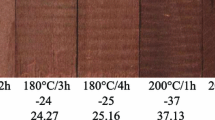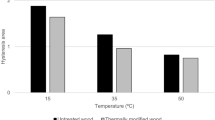Abstract
Weight losses and ultrastructural and chemical changes in pine and lime following exposure to deionised water in the temperature range 60° C-90° C are examined. Similar weight losses of 10% occur in pine and lime strips after 100 days exposure to water at 60 and 70° C but at 80 and 90° C lime shows greater weight losses (30%) than pine (15%). Observations of transverse surfaces exposed to water at 90° C for 50 days revealed separation of the secondary wall from the compound middle lamella region and some separation of individual cells. Chemical analysis of pine and lime wood flour exposed to deionised water at 65° C for 50 days revealed losses of hemicelluloses and lignin with little loss in cellulose. Changes in hemicellulose composition are thought to result primarily from degradation of pectinacious polysaccharides. Losses in lignin and hemicelIulose were higher and lower respectively in lime than in pine. Viscometry measurements on cuprammonium dispersions of holocellulose isolated from hot water exposed pine strips indicate that little depolymerisation of cellulose occurs. It is suggested that the chemical and ultrastructural changes noted here accord with the losses m wet tensile strength and toughness of hot water exposed thin wood strips and failure of these particularly in lime by inter-fibre shear.
Abstract
An Kiefern- und Lindenholz wurden Gewichtsverluste und Veränderungen der Ultrastruktur und der chemischen Zusammensetzung nach Wasserbehandlung zwischen 60 und 90 °C untersucht. Bei 60 und 70 °C ergibt sich in beiden Hölzern ein Substanzverlust von 10%. Bei 80 und 90 °C zeigt Lindenholz mit 30% einen deutlich größeren Gewichtsverlust als Kiefer (15%). Beobachtungen an Querschnitten der Proben zeigen Ablösungen der Sekundärwand von der Mittelschicht nach 50 Tagen Lagerung bei 90 °C. Auch Ablösungen einzelner Zellen treten in geringem Maße auf. Die chemische Analyse der Extrakte weist auf Verluste an Hemicellulosen und Lignin hin. Cellulose ist nur geringfügig betroffen. Vor allem pektinartige Hemicellulosen werden abgebaut. Aus Lindenholz werden mehr Lignin und Hemicellulosen ausgelöst als aus Kiefernholz. Der Abbau der Cellulose ist unbedeutend, wie viskosimetrische Messungen an Holocellulose in Cuoxam zeigen. Es wird angenommen, daß die hier gefundenen Veränderungen der Abnahme der Zugfestigkeit yon Heißwasser-behandelten Proben entsprechen, die insbesondere bei Linde als Verlust der Faser-Faser-Bindungen auftreten.
Similar content being viewed by others
Literatur
Aronovsky, S.I. 1930: The cooking process 1 — Role of water in the cooking of wood Ind. Eng. Chem. 22(3):264–274
Aspinall, G.O., Wood, T.M. 1963: The structures of two water-soluble polysaccharides from scots pine (Pinus sylvestris) J. Chem. Soc. II (316):1686–1696
Brower, H.E., Jeffery, J.E., Folsom, M.W. 1966: Gas chromatographic sugar analysis in hydrolyzates of wood constituents Anal. Chem. 38(2):362–364
Browning, B.L. 1967: Methods of wood chemistry. Vol. II. New York, London: Wiley
Groetschel, H. 1961: Arsenvergiftung. In: Baader, E.W.: Handbuch der gesamten Arbeitsmedzin, Bd. II. Urban u. Schwarzenberg, Berlin, München, Wien. 161 S.
Coupe, C., Watson, R.W. 1967: Fundamental aspects of weathering. Record Annual Convention. Br. Wood Preserv. Assoc. 2:37–49
Davis, W.H., Thompson, W.S. 1964: Influence of thermal treatments of short duration on the toughness and chemical composition of wood. For. Prod. J. 14(8):350–356
Evans, P.D., Banks, W.B. 1988: Degradation of wood surfaces by water. Changes in mechanical properties of thin wood strips. Holz Roh-Werkstoff. 46(11):427–435
Exley, R.R., Meylan, B.A., Butterfield, B.G. 1977: A technique for obtaining clean cut surfaces on wood samples prepared for the scanning electron microscope. J. Microsc. 110(1):75–78
Feist, W.C., Hon, D.N.-S. 1984: Chemistry of weathering and protection, Chap 11, 401–451. In: Rowell, R.M.: The Chemistry of solid wood. Adv. in Chem. Ser. 207. Wash. D.C.: Am. Chem. Soc.
Hawley, L.F., Wiertelak, J. 1931: Effect of mild heat treatments on the chemical composition of wood. Ind. Eng. Chem. 23(2):184–186
Ifju, G. 1964: Tensile strength behavior as a function of cellulose in wood. For. Prod. J. 14(8):366–372
Kurschner, K., Melcerova, A. 1965: Chemical changes of beechwood during thermal treatment. Part 1. Chemical changes of sawdust heated 1–28 days at 80–160°C. Holzforschung 19(6):161–171
Preston, R.D. 1984: Personal communication
Ritter, G.J., Seborg, R.M., Mitchell, R.L. 1932: Factors affecting quantitative determination of lignin by 72% sulfuric acid method. Ind. Eng. Chem. (Anal Ed) 4(2):202–204
Thompson, W.S. 1969: Effects of chemicals, chemical atmospheres, and contact with metals on southern pine wood: A review. Miss. State Univ. Forest Prod. Util. Lab. Res. Rept. 6:1–33
Worth, H.G.J. 1967: The chemistry and biochemistry of pectic substances. Chem. Rev. 67(4):465–473
Author information
Authors and Affiliations
Rights and permissions
About this article
Cite this article
Evans, P., Evans, P. Degradation of wood surfaces by water. Holz als Roh-und Werkstoff 48, 159–163 (1990). https://doi.org/10.1007/BF02617767
Published:
Issue Date:
DOI: https://doi.org/10.1007/BF02617767




